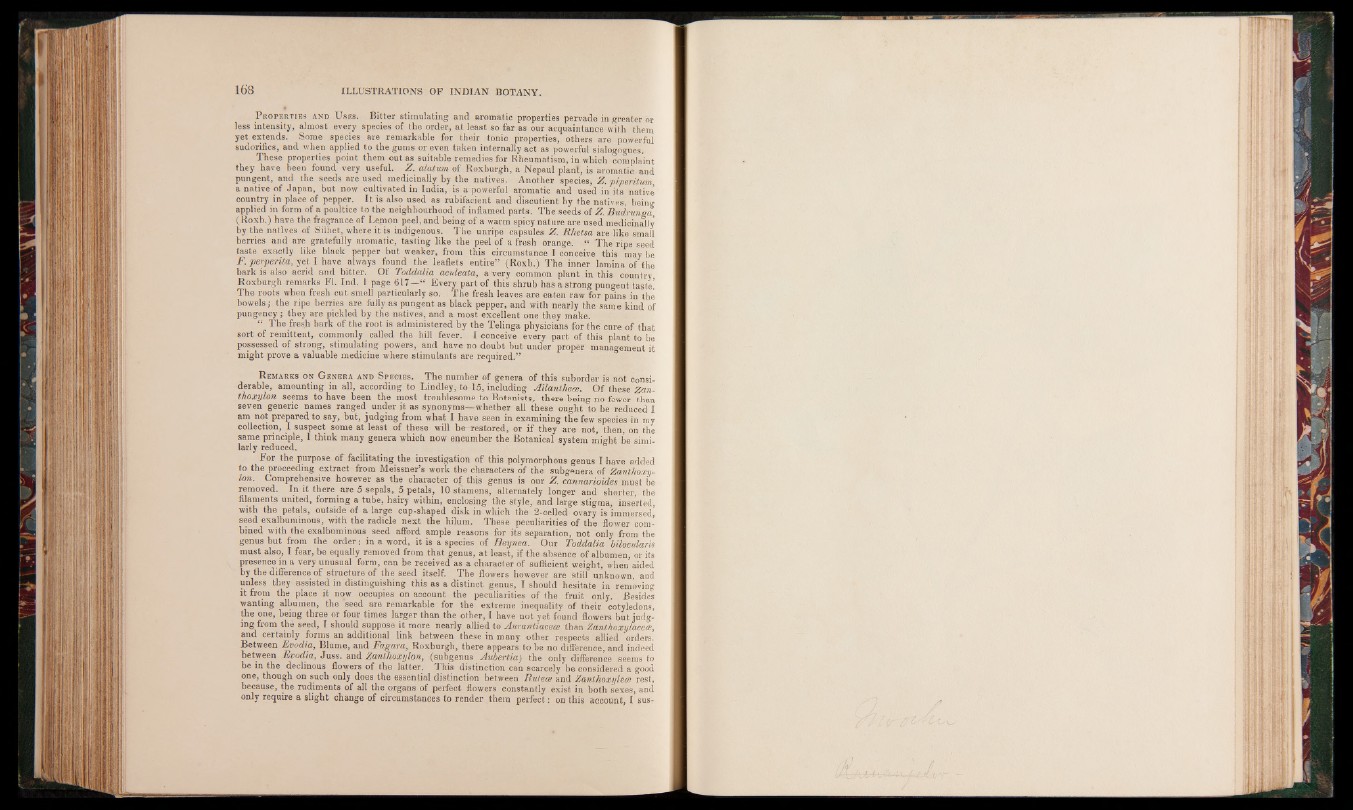
P roperties and Uses. Bitter stimulating and aromatic properties pervade in greater or
less intensity, almost every species of the order, at least so far as our acquaintance with them
yet extends. Some species are remarkable for their tonic properties, others are powerful
sudorifics, and when applied to the gums or even taken internally act as powerful sialogovues.
These properties point them out as suitable remedies for Rheumatism, in which complaint
they have been found very useful. Z. alatum of Roxburgh, a Nepaul plant, is aromatic and
pungent, and the seeds are used medicinally by the natives. Another species, Z. piperitum
a native of Japan, but now cultivated in India, is a powerful aromatic and used in its native
country in place of pepper. It is also used as rubifacient and discutient by the natives, being
applied in form of a poultice to the neighbourhood of inflamed parts. The seeds of Z. Budrunea
(Roxb.) have the fragrance of Lemon peel, and being of a warm spicy nature are used medicinally
by the natives of Silhet, where it is indigenous. The unripe capsules Z. Rhetsa are like small
berries and are gratefully aromatic, tasting like the peel of a fresh orange. “ The ripe seed
taste exactly like black pepper but weaker, from this circumstance I conceive this may be
F. perperita, yet I have always found the leaflets entire” (Roxb.) The inner lamina of the
hark is also acrid and bitter. Of Toddalia aculeata, a "very common plant in this country
Roxburgh remarks FI. Ind. 1 page 617—“ Every part of this shrub has a strong pungent taste
The roots when fresh cut smell particularly so. The fresh leaves are eaten raw for pains in thé
bowels; the ripe berries are fully as pungent as black pepper, and with nearly the same kind of
pungency; they are pickled by the natives, and a most excellent one they make.
“ The fresh bark of the root is administered by the Telinga physicians for the cure of that
sort of remittent, commonly called the hill fever. I conceive every part of this plant to be
possessed of strong, stimulating powers, and have no doubt but under proper management it
might prove a valuable medicine where stimulants are required.”
R emarks on G enera and S pecies. The number of genera of this suborder is not considerable,
amounting in all, according to Lindley, to 15, including Ailanthece. Of these Zan-
thoxylon seems to have been the most troublesome to Botanists, there being no fewer than
seven generic names ranged under it as synonyms—whether all these ought to be reduced I
am not prepared to say, but, judging from what I have seen in examining the few species in my
collection, I suspect some at least of these will be-restored, or if they are not, then, on the
same principle, 1 think many genera which now encumber the Botanical system might be simi-
larly reduced.
For the purpose of facilitating the investigation of this polymorphous genus I have added
to the proceeding extract from Meissner’s work the characters of the subgenera of Zanthoxy-
lon. Comprehensive however as the character of this genus is our Z. cannarioides must be
removed. In it there are 5 sepals, 5 petals, 10 stamens, alternately longer and shorter, the
filaments united, forming a tube, hairy within, enclosing the style, and large stigma, inserted,
with the petals, outside of a large cup-shaped disk in which the 2 -celled ovary is immersed!
seed exalbuminous, with the radicle next the hilum. These peculiarities of the flower combined
with the exalbuminous seed afford ample reasons for its separation, not only from the
genus but from the order: in a word, it is a species of Heynea. Our Toddalia bilocularis
must also, I fear, be equally removed from that genus, at least, if the absence of albumen, or its
presence in a very unusual form, can be received as a character of sufficient weight, when aided
by the difference of structure of the seed itself. The flowers however are still unknown, and
unless they assisted in distinguishing this as a distinct genus, I should hesitate in removing
it from the place it now occupies on account the peculiarities of the fruit only. Besides
wanting albumen, the 'seed are remarkable for the extreme inequality of their cotyledons,
the one, being three or four times larger than the other, I have not yet found flowers but judging
from the seed, I should suppose it more nearly allied to Aurantiacece than Zanthoxylaceai,
and certainly forms an additional link between these in many other respects allied orders.
Between Evodia, Blume, and Fagara, Roxburgh, there appears to be no difference, and indeed
between Evodia, Juss. and Zanthoxylon, (subgenus Aubertia) the only difference seems to
be in the declinous flowers of the latter. This distinction can scarcely be considered a good
one, though on such only does the essential distinction between Rut ecu and Zanlhoxyleai rest,
because, the rudiments of all the organs of perfect flowers constantly exist in both sexes, and
only require a slight change of circumstances to render them perfect; on this account, I susr